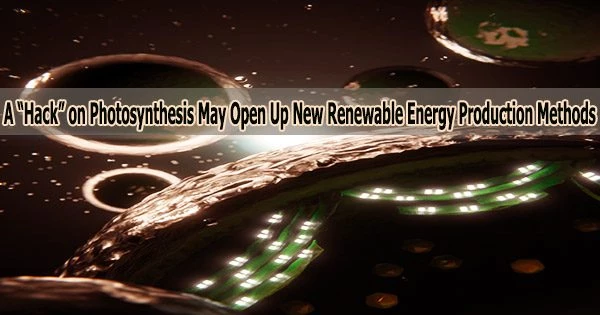Researchers have “hacked” the first phases of photosynthesis, the natural process that fuels the majority of life on Earth, and found new ways to harvest energy from it. This research may lead to new methods of producing clean fuel and renewable energy.
An international team of physicists, chemists, and biologists, under the direction of the University of Cambridge, has been able to study photosynthesis, the process by which some bacteria, plants, and algae convert sunlight into energy in living cells, at an ultrafast timescale of a millionth of a second.
Despite being one of the most well-known and extensively researched processes on Earth, the researchers discovered that photosynthesis still holds many mysteries. The researchers discovered that the compounds that can take electrons from the molecular structures essential for photosynthesis do so at the initial stages, rather than much later as was previously thought, using ultrafast spectroscopic techniques to study the movement of energy.
This “rewiring” of photosynthesis may lead to new and more effective ways for it to use its power as well as an improvement in how it handles extra energy. The results are reported in the journal Nature.
“We didn’t know as much about photosynthesis as we thought we did, and the new electron transfer pathway we found here is completely surprising,” said Dr. Jenny Zhang from Cambridge’s Yusuf Hamied Department of Chemistry, who coordinated the research.
Although photosynthesis is a natural process, researchers have been looking into how it may be used to combat the climate crisis, for instance by simulating photosynthetic processes to produce clean fuels from sunlight and water.
Many scientists have tried to extract electrons from an earlier point in photosynthesis, but said it wasn’t possible because the energy is so buried in the protein scaffold. The fact that we can steal them at an earlier process is mind-blowing. At first, we thought we’d made a mistake: it took a while for us to convince ourselves that we’d done it.
Dr. Jenny Zhang
Initially, Zhang and her coworkers sought to comprehend how a ring-shaped molecule known as a quinone is able to “steal” electrons from photosynthesis. Quinones are frequently found in nature and are readily able to accept and give away electrons. The quinones’ behavior in photosynthetic cyanobacteria was examined using a method known as ultrafast transient absorption spectroscopy.
“No one had properly studied how this molecule interplays with photosynthetic machineries at such an early point of photosynthesis: we thought we were just using a new technique to confirm what we already knew,” said Zhang. “Instead, we found a whole new pathway, and opened the black box of photosynthesis a bit further.”
The researchers discovered that the protein scaffold where the earliest chemical reactions of photosynthesis take place is ‘leaky,’ enabling electrons to escape. They did this by using ultrafast spectroscopy to watch the electrons. Plants may be able to defend themselves against harm from bright or rapidly varying light thanks to this leakiness.
“The physics of photosynthesis is seriously impressive,” said co-first author Tomi Baikie, from Cambridge’s Cavendish Laboratory “Normally, we work on highly ordered materials, but observing charge transport through cells opens up remarkable opportunities for new discoveries on how nature operates.”
“Since the electrons from photosynthesis are dispersed through the whole system, that means we can access them,” said co-first author Dr. Laura Wey, who did the work in the Department of Biochemistry, and is now based at the University of Turku, Finland. “The fact that we didn’t know this pathway existed is exciting, because we could be able to harness it to extract more energy for renewables.”
According to the researchers, altering photosynthetic pathways to produce clean fuels from the Sun could be more effective if charges could be extracted sooner in the photosynthesis process. In addition, the ability to regulate photosynthesis could mean that crops could be made more able to tolerate intense sunlight.
“Many scientists have tried to extract electrons from an earlier point in photosynthesis, but said it wasn’t possible because the energy is so buried in the protein scaffold,” said Zhang. “The fact that we can steal them at an earlier process is mind-blowing. At first, we thought we’d made a mistake: it took a while for us to convince ourselves that we’d done it.”
The use of ultrafast spectroscopy, which allowed the researchers to track the energy flow in the active photosynthetic cells on a femtosecond scale a thousandth of a trillionth of a second was crucial to the discovery.
“The use of these ultrafast methods has allowed us to understand more about the early events in photosynthesis, on which life on Earth depends,” said co-author Professor Christopher Howe from the Department of Biochemistry.
The research was supported in part by the Engineering and Physical Sciences Research Council (EPSRC), Biotechnology and Biological Sciences Research Council (BBSRC) part of UK Research and Innovation (UKRI), as well as the Winton Programme for the Physics of Sustainability at University of Cambridge, the Cambridge Commonwealth, European & International Trust, and the European Union’s Horizon 2020 research and innovation programme.
Jenny Zhang is a David Phillips Fellow at the Yusuf Hamied Department of Chemistry, and a Fellow of Corpus Christi College, Cambridge. Tomi Baikie is a NanoFutures Fellow at the Cavendish Laboratory. Laura Wey is Novo Nordisk Foundation Postdoctoral Fellow at the University of Turku.





